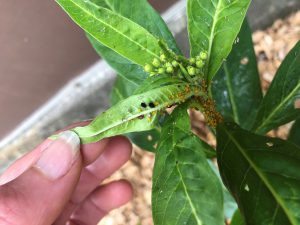
Milkweed (Asclepias spp) plants are a must have addition to any butterfly garden due to their great importance as the only host plant species for monarch caterpillars. There are many varieties of milkweeds, from our native orange butterfly weed (Asclepias tuberosa) to the non-native tropical milkweed (Asclepias curassavica) with clusters of orange, red and yellow tubular flowers. Not only are milkweeds a host plant, they are also highly attractive nectar plants for many pollinators.
Unfortunately, milkweeds have an arch nemesis – the oleander aphid (Aphis nerii). Also called the milkweed aphid, these voracious eaters are commonly seen completely coating the new growth of milkweed, sucking the juices from the plants and excreting a sweet mildew-producing substance called honeydew.
Oleander aphids typically have little bright yellow, round bodies with dark legs, antennae and siphunculae (two tube-like structures near the back of the abdomen that excrete honeydew). Of course, it’s not that easy. As the nymphs molt, they also leave behind white skins that can be confused for other insects and some adult oleander aphids even produce wings.
Fortunately, there are multiple aphid predators working in our favor, including many species of parasitic wasps and ladybugs. The parasitic wasps lay eggs in the bodies of the aphids, turning them a dark color. Eventually the eggs hatch from within and kill the aphid, leaving behind hollow aphid carcasses called “mummies.” Both ladybug adults and the nymphs are excellent aphid hunters and can be released for added biological control. If there’s little evidence of parasitism, horticultural soaps or neem oil spot sprayed on the aphids are also effective.
For more information, visit http://entnemdept.ufl.edu/creatures/orn/shrubs/oleander_aphid.htm or call your UF/IFAS Extension Marion County at 352-671-8400.
 0
0
